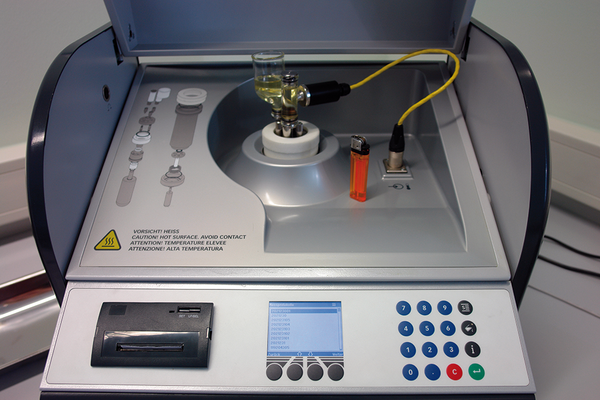Dielectric dissipation factor
Year of publication: 2011
Test standard: IEC 60247, ASTM D924 Measuring range: tan δ up to 1x10-6 Sample volume: 200 ml Determined: Dissipation factor tan δ relative dielectric constant εr.
The dielectric dissipation factor tan δ measured with a Baur DTL-C provides information on the extent of dielectric losses in the transformer oil occurring during operation. It is defined as the ratio between the active and reactive currents flowing in a measurement circuit. In determining the dielectric dissipation factor, it is assumed that current and voltage in an alternating current circuit are subject to a phase shift. This means that the voltage precedes the current by 90° degrees because voltage is already present although no current is flowing yet. This phase change is due to the fact that molecules in the insulation oil can no longer align with the alternating electric field. In order to define the tan δ, the measuring cell of the device is filled with 40 ml of oil and heated to a standard 90 °C. A test voltage of 2,000 V at a frequency of 50 Hz is applied across the two electrodes of the measuring cell, which are arranged at a distance of 2 mm. The dielectric dissipation factor is dimensionless. It is noted in the laboratory report as tan δ, with a corresponding numerical value.
When the oil ages, polar components occur in the oil, leading to a phase displacement and in turn to dielectric losses in the insulating oil. Impurities such as water, dissolved insulating resin and paper can also have polar effects and thereby influence the dielectric dissipation factor. The tan δ is also significantly influenced by the temperature-dependent viscosity, and with it, the size of the molecules, in addition to the ageing of the oil and the impurities. The sum of these changes is expressed as tan δ .
At the same time, the dielectric constant εr required for the design of most on-line oil sensors is also defined during measurement. A sharply negative trend of the dissipation factor indicates unwanted heat generation within the insulating liquid and the fixed insulation, which can ultimately lead to thermal breakdown. For this reason, this test is highly significant for assessment of the condition of the complex arrangement of a transformer.




